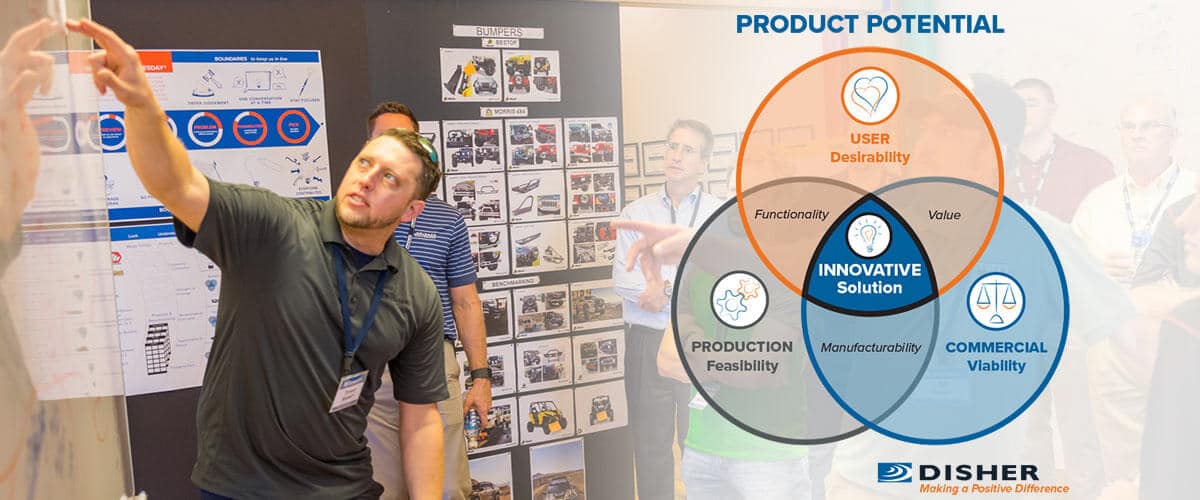Get More Hits in Product Development
March 3, 2017

Written By:
Jeff Disher | Founder & Chairman of the Board

As the owner of a product development firm, I often receive calls that go something like this, “We have this idea for a new product, but we’re not sure how to get it developed— can you help us?” As the conversation continues, I sense that they think their idea is a big winner… and visions of early retirement are already dancing in their heads.
Some believe that all they need to do is just breathe the hint of their idea to me and I will drop everything and make them a millionaire. After all, that’s what I do, right? Well, if it were that easy we’d all be millionaires sipping cool drinks on some tropical beach somewhere. Which off course, I am not because I am sitting here at my computer about to tell you that innovation success is difficult. Sorry to dampen anyone’s happy dance. The hard reality is that a very small percentage of ideas actually get to participate in the game of making money. Take a look at these statistics.
+ 52% of all patent applications were awarded as patents in the last 4 years (US Patent Office)
+ 2% of the 50% of awarded patents reach the market (The Innovators Bible)
+ 25% of the 2% new product patents that reach the marketplace achieve profitable volume (Product Development Institute)
Of all the patents applied for, only 0.25% are successful (reach a profitable volume) in the market. In baseball terms, that’s like batting .0025 or getting a hit every 400th time at bat.
What makes innovation so difficult?
There are many reasons why it’s difficult. Here are the most common:
1. It takes too long. Most innovations emerge over extended periods of time. In fact, one study suggests that it often takes 30 years (The 30 Years Rule – Innovation Takes A Lot Longer Than You Think by Greg Stell, January 8, 2017).
2. It’s too complicated. The risks and difficulties are underestimated along the way. A while back, BusinessWeek ran the cover story, “Innovation Interrupted”, which took a look at why nine significant innovations were slow to commercialize ten years later. These innovations ranged from cancer treatment and MEMS to fuel-cell-powered cars and tissue engineering. Seven of these nine innovations gave the same reason for their lack of results: “It was far more complicated than originally anticipated.”
3. There are too many errors. Poor execution during the project by the team can cause failure.
4. There’s not enough funding. Innovation takes considerable resources in time, people, and money. If it is not strategically budgeted for— it will not happen.
5. There’s too much competition. If the market is saturated with similar products and low margins, it usually is not wise to jump in.
6. Designing in a vacuum with either too much ignorance or too much arrogance is detrimental. Ignorance is not knowing what you don’t know and arrogance is thinking you know it all. Both lead to innovating with limited information. Companies can go way too far down a dead-end path. According to Dr. Robert G. Cooper of the Product Development Institute, this is the biggest reason why innovation fails.
What does it take to get a hit?
Whether you’re working with a design team for a customer’s product or you are developing your own new product, you can improve your chances of success. Vet concepts quickly (a fail fast forward approach), strive to solve the RIGHT problem, and solve that problem RIGHT. Makes sense, but how?
3 Core Disciplines for Product Innovation
A proven approach that will help you achieve more product development singles, doubles, and maybe even a home run involves doing some serious homework in three core areas:
1. User Desirability
2. Commercial Viability
3. Production Feasibility
When all three are understood and accomplished, your chances of connecting with the ball significantly increase. Often, companies or individuals approach product development with strength in only one of these disciplines. They don’t have a balanced game. For example, engineers and designers tend to focus on Production Feasibility and skimp on understanding whether the consumer will pay for it and if there is a real business case for it. Maybe it’s not their job to understand these other areas, but someone on their team needs to gather all of the facts. If any one of these disciplines is disregarded, the team will likely fail.
Even with competency in two of these areas, you can not leave out the third discipline. If you neglect User Desirability, for example, you may produce a product that no one wants to buy. If you leave out Commercial Viability, you may produce a product that can’t make money. If you leave out Production Feasibility, you may end up manufacturing a product that doesn’t work well or has poor quality. In each of these scenarios, we end up going too far down the path of failure before we realize it. We waste money. We waste time. We strike out!
This three-disciplined approach allows you to identify and address the biggest risks to market success early in the game. Understanding User Desirability helps you determine the value (features and price) for which consumers are willing to pay. This activity helps you solve the right problem. Some experts suggest that consumer research is the most often skipped activity in new product development; hence, the cause of most of the market failures of new products.
Addressing Commercial Viability helps you know if the financials can work all the way through the value stream. While understanding Production Feasibility helps you know if the right product solution is possible given all the targets. Commercial Viability and Production Feasibility help you solve problems right. If you get back to solving the right problems and solving those problems right, you and your customer will have a much higher batting average.
There are many curveballs in new product development. They can strike you out if you aren’t prepared. Get in the game by doing your homework in the three core disciplines, and maybe you and your team can start doing a real victory dance.


